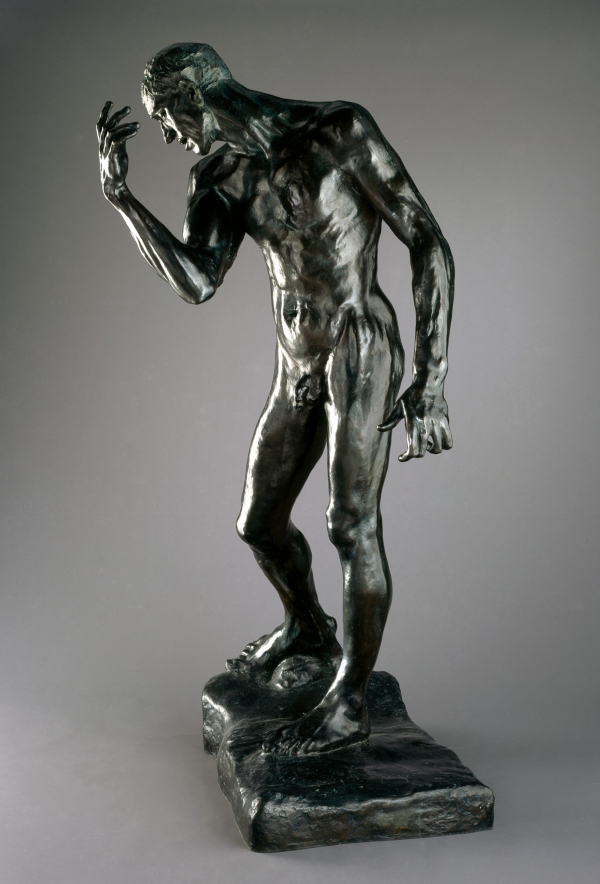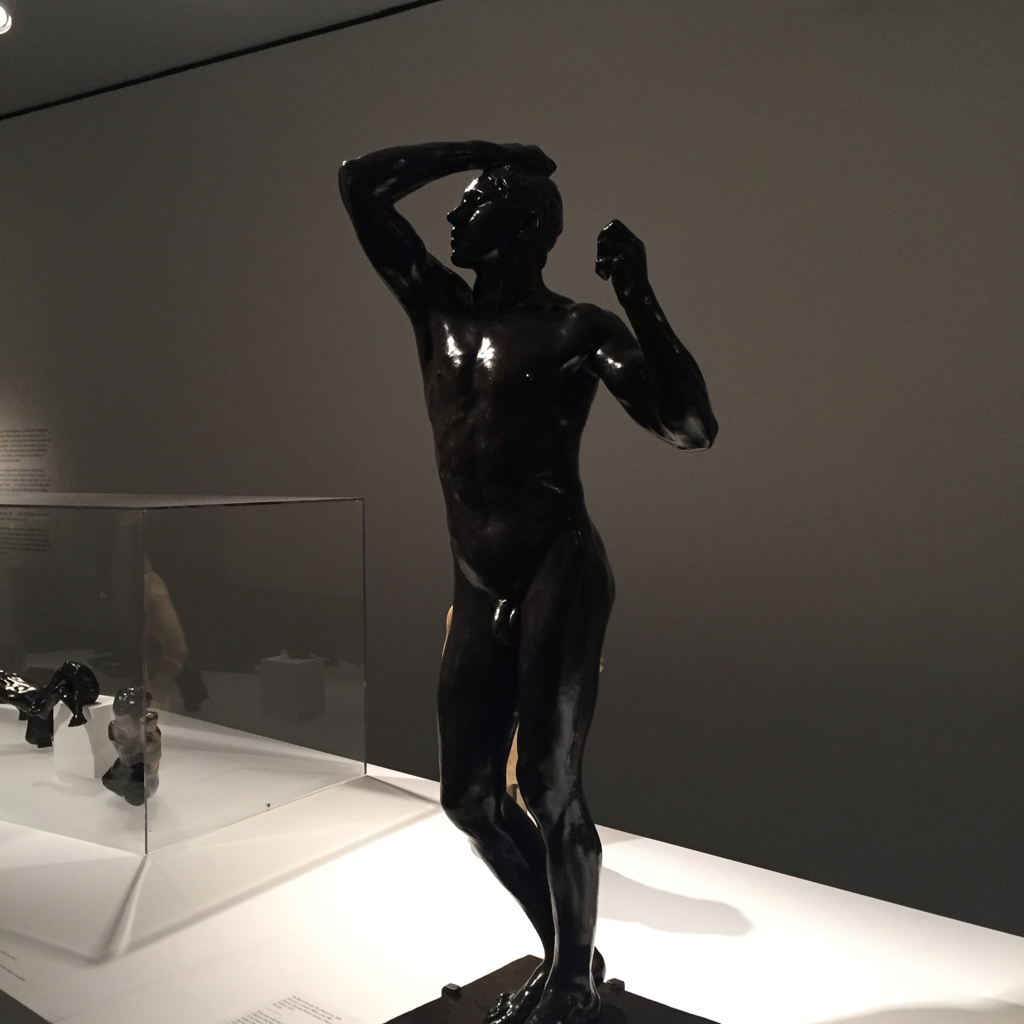
Auguste Rodin (French, 1840–1917). Pierre de Wiessant, Monumental Nude, 1886, cast 1983. Cast by Fonderie de Coubertin, Saint-Rémy-lès-Chevreuse. Bronze, 781/4 x 443/4 x 361/2 in. (198.8 x 113.7 x 92.7 cm). Brooklyn Museum; Gift of the B. Gerald Cantor Collection, 86.310. (Photo: Justin Van Soest)

Auguste Rodin (French, 1840–1917). Pierre de Wiessant, Monumental Nude, 1886, cast 1983. Cast by Fonderie de Coubertin, Saint-Rémy-lès-Chevreuse. Bronze, 781/4 x 443/4 x 361/2 in. (198.8 x 113.7 x 92.7 cm). Brooklyn Museum; Gift of the B. Gerald Cantor Collection, 86.310. (Photo: Justin Van Soest)

Auguste Rodin (French, 1840–1917). Monument to the Burghers of Calais, First Maquette, November 1884, cast circa 1967. Cast by Émile Godard Fondeur, Paris. Bronze, 233/4 x 147/8 x 13 in. (60.3 x 37.8 x 33 cm). Brooklyn Museum; Gift of the Iris and B. Gerald Cantor Foundation, 84.75.19. (Photo: Justin Van Soest)
This is a cast of the initial maquette, or model, that Rodin submitted to the town council of Calais to secure the commission for The Burghers of Calais monument. Departing from the council’s original suggestion to focus just on Eustache de Saint-Pierre, he decided to include the other five burghers: Jean d’Aire, brothers Jacques and Pierre de Wiessant, Andrieu d’Andres, and Jean de Fiennes. He arranged the tightly packed figures in three groups, each facing a different direction. This composition enabled him to examine the idea of collective sacrifice while also exploring individual responses through a variety of poses and facial expressions.
In this first model, the burghers are physically intertwined and elevated on a substantial base. As the project progressed, the appearance of each figure evolved, and Rodin made them independent of each other. He also abandoned the pedestal in favor of a more emotionally immediate siting:
I did not want any pedestal for these statues. I wanted them to be placed on, or even affixed to, the paving stones of the public square in front of the Hôtel de Ville in Calais, so that it looked as if they were leaving there in order to go out to the enemy camp. In this way, they would have . . . mixed with the daily life of the town: passersby would have elbowed them, and they would have felt keenly through this contact the emotion of the living past in their midst.

Auguste Rodin (French, 1840–1917). Paolo and Francesca, before 1886, cast 1981. Cast by Georges Rudier Fondeur, Paris. Bronze, 113/4 x 231/4 x 105/8 in. (29.8 x 59.1 x 27 cm). Brooklyn Museum; Gift of the Iris and B. Gerald Cantor Foundation, 86.1. (Photo: Justin Van Soest)
Paolo and Francesca is one of only two direct references in The Gates of Hell to the “Inferno” portion of Dante’s Divine Comedy. Dante encounters the couple in the second circle of Hell, where carnal sinners are punished. There, the condemned and slain pair, whose love was unconsummated, are together forever, constantly reminded of their first kiss but unable to satisfy their most passionate desires. Francesca confesses to Dante that there is “no greater grief than to recall a bygone happiness.” Rodin accentuated their eternal frustration by inserting a mass between their writhing bodies.

Auguste Rodin (French, 1840–1917). Seated Bather with Feet Apart, 1895–1900; cast after 1972. Cast by Georges Rudier Fondeur, Paris. Bronze, 51/8 x 63/4 x 43/8 in. (13 x 17.1 x 11.1 cm). Brooklyn Museum; Gift of the Iris and B. Gerald Cantor Foundation, 84.75.1. (Photo: Sarah DeSantis)
Rodin sculpted a head as part of the original clay figure for this work, but it accidently broke off, presumably due to its weight and position leaning over the body. It is a testament to his belief that a work of art need not include the entire human form to realize its full expressive potential that he decided to cast the work in its headless state.
Rodin often encouraged his models to adopt unusual poses such as this one, as opposed to those from the stale repertoire of academic art.

Auguste Rodin (French, 1840–1917). Balzac, Second Study for Nude F, 1896; cast 1979. Cast by Georges Rudier Fondeur, Paris. Bronze, 37 x 16 x 151/2 in. (94 x 40.6 x 39.4 cm). Brooklyn Museum; Gift of Iris and B. Gerald Cantor, 84.77.10
This is likely one of the final nude studies for the figure beneath the drapery in the completed Balzac monument. Instead of an aging, dissipated body, which the commission had criticized, Rodin turned to a more athletic and muscular figure. That he sought to portray a very specific conception of genius is evident in his decision to make the author’s right hand grip his erect penis, explicitly equating male sexual virility with artistic creativity. Balzac surely would have agreed: his wife recalled a letter in which he had once explained that he prepared himself to write his novels by “masturbating his brain.”

Auguste Rodin (French, 1840–1917). Head of the Tragic Muse, 1895; cast 1979. Cast by Georges Rudier Fondeur, Paris. Bronze, 115/8 x 71/4 x 97/8 in. (29.5 x 18.4 x 25.1 cm). Brooklyn Museum; Gift of the Iris and B. Gerald Cantor Foundation, 84.75.12
This remarkable bust was originally created for Rodin’s Monument to Victor Hugo, as part of an allegorical female figure speaking passionately to the author. A number of critics decried it as an unfinished deformity. Others felt her shifting, fluid features effectively symbolized the processes of consciousness, creativity, or genius. As one critic remarked, Rodin’s tragic muse certainly broke with tradition, being “at a droll remove from the licked prettiness of the customary nymph.”
What remains startling today is the degree to which Rodin abandoned lifelike representation in this work. It had instead become about the emotional impact—divorced from facial or narrative legibility—conveyed by the artist’s visible manipulation of the material.

Edward Steichen (American, born Luxembourg, 1879–1973). M. Auguste Rodin, 1911. Photogravure, image: 101/4 x 7 in. (26 x 17.8 cm). Brooklyn Museum; Gift of Arnold and Pamela Lehman, 2003.76.2
This portrait of Rodin, in a pose reminiscent of his famous composition The Thinker, appeared in Alfred Stieglitz’s modern art and photography periodical Camera Work in 1911. Edward Steichen met and became close to the sculptor in Paris in 1901, and in 1908 he arranged for an exhibition of Rodin’s drawings to be held at Stieglitz’s 291 gallery in New York.

Auguste Rodin (French, 1840–1917). The Age of Bronze, First Reduction, 1876 (reduction probably 1903‒04), cast 1967. Cast by Georges Rudier Fondeur, Paris. Bronze, 411/4 x 15 x 13 in. (104.8 x 38.1 x 33 cm). Brooklyn Museum; Gift of the Iris and B. Gerald Cantor Foundation, 68.49. (Photo: Justin Van Soest)
This male nude was initially called The Vanquished, in tribute to the French people after their decisive defeat in the Franco-Prussian War (1870–71). In treating this subject, Rodin was engaging with classical antiquity and with Michelangelo, who had dealt with the theme of spiritual and physical defeat in his Slave sculptures, two of which Rodin knew from the Louvre. But Rodin departed from the idealization that characterized the traditional male nude by relying on the “unimproved' body of a real model. Over a period of eighteen months, he scrutinized his model from all angles, capturing every shifting contour of the body. When he exhibited the life-size plaster at the Salon of 1877 he called it The Age of Bronze, a title that invited a range of subjective responses. Its enigmatic gestures revealed no clear meaning, and its naturalism led some critics to falsely accuse the artist of making a cast directly from the body of the model.
The half-life-size version seen here was probably first produced in 1903–4 in response to popular demand for an edition at a reduced size of Rodin’s first major work.
Rodin at the Brooklyn Museum: The Body in Bronze
November 17, 2017–April 22, 2018
We mark the hundredth anniversary of Auguste Rodin’s death, in 1917, with an installation of our remarkable collection of 58 Rodin bronzes, acquired through a generous gift from the Iris and B. Gerald Cantor Foundation in 1983.
Rodin at the Brooklyn Museum: The Body in Bronze highlights the extraordinary tension in Rodin’s work between the figure itself and abstract form, allowing the fluid contours, animated surfaces, and emotional presence of these bronzes to emerge fully. The presentation places the works in their historical context, examining Rodin’s legacy and reputation, and exploring his sculptural practice and the bronze casting process.
Rodin heralded a new era in sculpture, and he is represented here through each phase of his prolific career, including both small and monumental works related to his best-known commissions: The Gates of Hell (begun 1880), the Monument to Balzac (1891–98), and The Burghers of Calais (1884–95). Also featured are some of his sensitively rendered studies of hands as well as fragments of ancient sculptures from our collection that are similar to those that inspired Rodin.
Rodin at the Brooklyn Museum: The Body in Bronze is organized by Lisa Small, Senior Curator, European Art, Brooklyn Museum.




